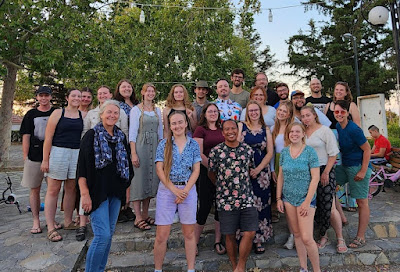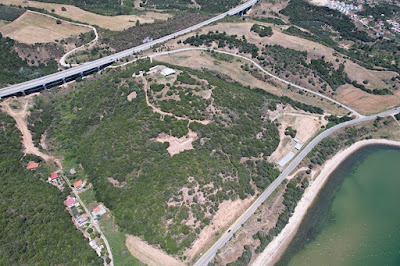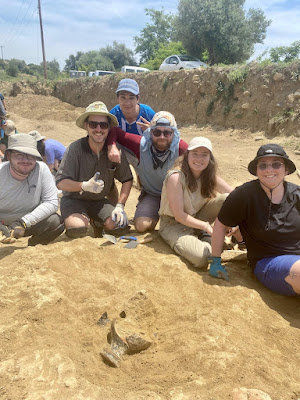From L-R: Justine Lefebvre, Taryn Rankin and Athena Wakeling
The new academic year has begun at the Institute, and we welcome the Institute’s 2023-2024 Neda and Franz Leipen Fellow, Justine Lefebvre, Georgian College intern, Athena Wakeling, and Wilfrid Laurier University intern, Taryn Rankin.
Justine Lefebvre is a PhD candidate in History at Université de Montréal, under the supervision of the Institute’s Director, Prof. Jacques Perreault. Her research focuses on metal production in Northern Greece during the archaic and classical periods, through the study of the specific case of bronze production at Argilos during these periods.
Located a few kilometers west of the Strymon river in Northern Greece, Argilos is an ideal location for the development of its metal production: an abundance of surrounding metal resources, a prosperous economy, and good relations with the Thracian populations from whose metallurgical expertise it can benefit. In order to thoroughly study this metallurgical production, the thesis relies on a multidisciplinary approach, combining traditional archaeological methods and archaeometry. Indeed, a sampling of bronze artifacts from the vast inventory collected in Argilos since 1992 will be subjected to typological, metallographic, chemical, and isotopic analyses. The results obtained through these analyses will provide a detailed picture of metallurgical production in Northern Greece throughout the Archaic and Classical periods, by identifying the nature and quality of Argilos’ production, and by evaluating how it fits into its regional context, in terms of distribution of raw resources and finished products.
Thanks to the Neda and Franz Leipen Fellowship, Justine hopes to complete the writing of her thesis, to which her nine-month stay in Greece is instrumental. First, a presence in Athens will allow her to benefit from easy access to the valuable resources available in the libraries of the Canadian Institute and other foreign research institutes, as well as in the numerous archaeological museums. Moreover, a stay in Northern Greece will allow her to visit the archaeological museum of Amphipolis, with the aim of completing the study of archaeological material linked to Argilian metallurgical production, as well as to study that which is still in situ at Argilos.
Athena Wakeling is a Wilfrid Laurier University graduate who received her BA in Archaeology and Anthropology in 2021. Athena is currently completing her postgraduate degree at Georgian College, specializing in Museum and Gallery studies, and will be completing her semester internship at the Canadian Institute in Greece.
Throughout her three programs, Athena has gained knowledge and understanding around topics connecting theoretical concepts of culture and history, while applying them into the real function of Museums or Galleries in the 21st century.
Athena is eager to get hands-on experience in the archival documentation field of work and will be applying her skills to the archives at the Institute, continuing the organization and documentation of past site reports and records across Greece. While Athena is in Greece, she intends to travel around the country and educate herself about Greek culture and history since she has direct familial roots to the country.
Taryn Rankin is a fourth-year undergraduate studying at Wilfrid Laurier University with a double major in Ancient Studies and Anthropology. Upon graduating, Taryn is interested in continuing her ancient history and anthropological studies at a graduate level with a focus on ancient and modern ethnobotany.
In her studies, Taryn has learned how to work with and understand multiple forms of media and research which is important in being able to make information approachable to all audiences as well as the importance of easily accessible knowledge through physical and online libraries.
Taryn will use her skills and knowledge gained from her studies to work in the Institute’s library to increase its resources and the knowledge available to its visitors while also using her time in Athens to learn about Greek life and history. By the end of the internship, she hopes to have new-found knowledge and experience that will aid her in completing her studies and future career.
Jonathan Tomlinson
Assistant Director





















